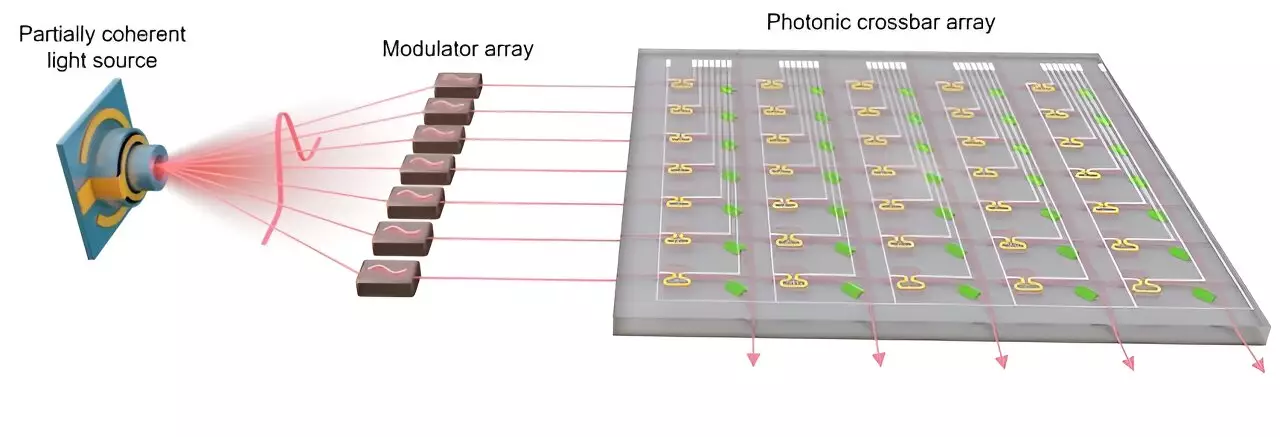In the rapidly evolving landscape of photonic computing, a groundbreaking revelation has emerged that challenges the long-held belief that coherence is king when it comes to light sources. Researchers from the University of Oxford and their European collaborators have unveiled that utilizing partially coherent light sources could provide a noteworthy performance enhancement in certain optical computations, particularly those tied to artificial intelligence (AI). This new paradigm not only holds the promise of creating more affordable and energy-efficient technologies but also challenges conventional notions that have dictated the reliance on expensive lasers.
Traditionally, the industry has upheld that highly coherent light sources—such as lasers, which emit incredibly precise and uniform wavelengths—are optimal for systems that require high-resolution and accuracy. Their characteristics have paved the way for advancements in fields like medical imaging, telecommunications, and remote sensing. Hence, it was widely regarded that coherence directly correlates with improved functionality. However, the findings from this recent study introduce an intriguing complexity: less coherent light can, in some cases, outperform its more expensive counterparts.
Harnessing the Power of Partial Coherence
The crux of this study involves the utilization of an electrically-pumped erbium-doped fiber amplifier to create partially coherent light. By tapping into a narrow portion of the spectrum emitted by this fiber, the researchers successfully harnessed the benefits of incoherent light without sacrificing the speed needed for AI computations. Interestingly, this partially coherent light can be split and directed into multiple input channels in a parallel AI computational architecture, demonstrating a remarkable scaling capability.
With this innovative approach, the researchers were able to showcase a photonic AI accelerator, significantly enhancing its processing speed by a factor of N, where N represents the number of input channels. In practical terms, their system achieved over 100 billion operations per second, performing complex calculations at speeds on par with state-of-the-art coherent photonic systems, traditionally achieved only with multiple lasers. This leap in performance not only opens up new horizons in AI processing but also sets the stage for a potential shift in how photonic technologies are developed and utilized.
Applications Beyond AI
The implications of these findings are far-reaching, extending beyond mere computational speed. For instance, the successful classification of individuals with Parkinson’s disease by analyzing walking patterns illustrates the transformative potential of this technology in the medical field. Such breakthroughs reinforce the argument that the utilization of lower-coherence light sources may not only simplify systems but also enhance their effectiveness in critical applications, especially as machine learning continues to permeate various sectors.
Additionally, this study alludes to potential applications in optical communications. As industries strive for faster and more efficient data transfer methods, the ability to leverage partially coherent light could also revolutionize optical interconnects, which are crucial for upcoming data transmission technologies. This presents a compelling argument for reconsidering foundational principles surrounding light sources in not just computing, but in vast domains including telecommunications and sensor technologies.
Challenging Conventional Wisdom in Photonics
It is time to challenge the established wisdom of photonics. The steadfast belief that coherence directly equates to enhanced performance must be deliberated anew in the face of these compelling findings. As we witness this paradigm shift, it necessitates a re-evaluation of methodologies and strategies in developing future photonic technologies. This study does not merely present a new avenue for exploiting fundamental physics; rather, it advocates for a nuanced understanding of how light behaves and the myriad ways we can harness it.
As we move forward, with researchers like Dr. Bowei Dong and Professor Harish Bhaskaran leading the way, we can expect innovations that previously seemed impractical. The emergence of partially coherent light sources may very well mark the dawn of a new era in the realm of photonic computing, ushering in technologies that are faster and more adaptable than ever before. In doing so, this work plants the seeds for a brighter, more efficient future, wherein the limitations of our current understanding of light are surmounted by inventive approaches and groundbreaking technologies.


Leave a Reply